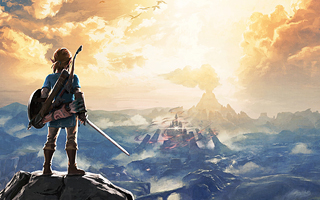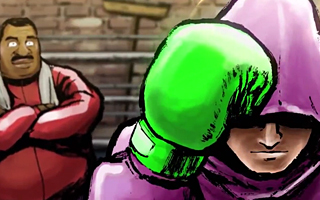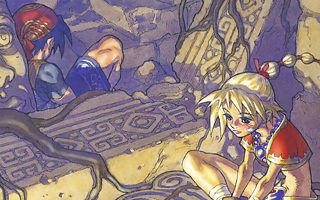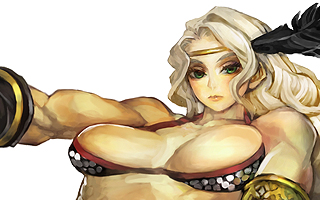The Comeback Kid
Top 10 Best Video Game Comebacks of All Time!
It’s inspirational to watch someone climb the mountain of success. In the event that someone falls from the summit, an added element of redemption is applied when they inevitably try to claw their way back up to the top. When someone makes a dramatic comeback, they embody the traits of a winner and an underdog at the same time – and this makes it nearly impossible to root against them. Some of the characters on this list faded into obscurity while others were merely placed on the back burner, but it was exciting to see them in the public eye again. Everyone loves a good comeback story.
Examples: Batman, James Bond, My Little Pony

10
Oswald the Lucky Rabbit
Epic Mickey
I’m bending the rules by including a non-gaming character on this list, but there are extraneous circumstances. Oswald the Lucky Rabbit was created by Walt Disney and Ub Iwerks in 1927, but Universal Studios claimed the rights to the character the following year. Mickey Mouse was created as a replacement, and Oswald fell to the wayside. Disney finally reclaimed the rights to Oswald nearly 80 years later, and the release of Epic Mickey in 2010 marked his return to prominence. (The game also marked the first time Mickey and Oswald ever appeared together!) The game dealt with the Oswald’s feelings of abandonment and his envy of Mickey, and its metafiction plot mirrored Oswald’s real-world history. Even though he’s not a gaming character, I felt compelled to give Oswald an honorary position on this list.

9
Samus Aran
Metroid: Fusion & Metroid Prime
Although Samus Aran was never in any danger of being forgotten, her presence was sadly missed during the Nintendo 64 era. Super Mario 64 and Ocarina of Time were transcendent games, but Metroid wasn’t given a next-gen treatment. On November 18, 2002 – eight years after the release of Super Metroid – Nintendo released two new Metroid games. Metroid Fusion (for the Game Boy Advance) was a direct sequel to Super Metroid and featured the tried-and-true 2D gameplay we all knew and loved. On the same day, Nintendo also released Metroid Prime for the GameCube and gave fans the 3D Metroid they never knew they wanted. That’s one heck of a homecoming. By pulling double duty, Samus was able to break new ground without alienating her longtime fans.

8
Shantae
Shantae: Risky’s Revenge
Shantae was an ambitious platformer that was developed by WayForward Technologies and published by Capcom. The game pushed the boundaries of the Game Boy Color in 2002, but its sales numbers were lackluster. Sadly, WayForward had to cancel the planned Game Boy Advance sequel because they were unable to find a publisher. Fortunately, they didn’t give up on Shantae, and they were eventually able to self-publish a sequel through Nintendo’s DSiWare service. Shantae: Risky’s Revenge put the half-genie hero back on the map after an eight-year hiatus, and fans accepted her with open arms. The belly-dancing protagonist has even made guest appearances in other games. Shantae faced rejection on an industry-wide level, but she couldn’t be bottled up forever.

7
Mega Man
Mega Man 9
The Mega Man franchise has spawned a number of spinoffs over the years – including Mega Man X, Mega Man Legends, Mega Man Battle Network, Mega Man Star Force, and probably a few others that I’m forgetting about. For the 2009 release of Mega Man 9, however, Capcom decided to return to their roots. It had been over a decade since Mega Man 8 had been released, and Capcom turned the clock back even further by intentionally making Mega Man 9 look and sound like a NES game! I’ve always been partial to Mega Man’s classic design, and Mega Man 9 was a return to form for the Blue Bomber. He was every bit as endearing in 2008 as he was in 1987, and it kind of makes you wonder if all the new versions of Mega Man were really necessary.

6
Little Mac
Punch-Out!!
The boxing world is a perfect environment for a great comeback story, so Little Mac’s a great fit for this list. As the star of Punch-Out!!, Little Mac gained fame by routinely fighting opponents that were twice his size while being coached by an incompetent cornerman. Inexplicably, Mac packed on about 50 pounds of muscle in Super Punch-Out!! before emerging in the Japan-only Captain Rainbow as an obese shell of his former self. The scrappy underdog we grew up with had been reduced to a joke character. Thankfully, the 2009 Punch-Out!! reboot was a return to form for both Little Mac and the series itself. The game gave everyone a reason to root for Little Mac again, and the extra exposure eventually led to him being immortalized in the Super Smash Bros. series.

5
Solid Snake
Metal Gear Solid
Solid Snake is one of gaming’s most iconic heroes, so it’s hard to believe he was ever at risk of being forgotten. There was an eight-year wait between Metal Gear 2 and Metal Gear Solid, however, and the series missed the entire 16-bit era. Most fans outside of Japan never had the change to play Metal Gear 2, and the unofficial sequel (Snake’s Revenge) wasn’t exactly Konami’s best work. It looked like the series was on life support, but Konami spent several years developing Metal Gear Solid and ended up revolutionizing the industry. Metal Gear Solid popularized the stealth genre and introduced millions of gamers to Solid Snake. Many of the characters on this list were completely redesigned, but all Solid Snake ever needed was a brighter spotlight.

4
Ryu Hayabusa
Ninja Gaiden
Ninja Gaiden was one of the best franchises on the NES. Unfortunately, the series didn’t evolve during the 16-bit era and it was MIA during the 32-bit era as well. While the Ninja Gaiden series was on an indefinite hiatus, a cash-strapped Tecmo released a provocative fighting game called Dead or Alive in 1996 that featured Ryu Hayabusa as a playable character. DOA kept Ryu in the public eye, but he was overshadowed by the top-heavy babes that surrounded him. In 2004, he was finally thrust back into the limelight when Tecmo decided to reboot Ninja Gaiden on the Xbox. The game pushed the boundaries of the action genre just like the originals had done decades earlier, and a new generation of fans finally got to see the Super Ninja in his natural environment.

3
Nova
StarCraft II
November Annabella Terra (call sign “Nova”) is a covert operative and one of the most powerful psionic soldiers in the StarCraft universe. She was slated to star in StarCraft: Ghost, but the game was put on “indefinite hold” in 2006. Nova’s story could have ended there, but Blizzard decided that she was worth saving even if the game itself wasn’t. Nova was properly introduced in the Wings of Liberty campaign for StarCraft II in 2010. The deadly assassin only appeared in an optional mission, but Blizzard continued to promote her in the years that followed. In 2016, she was finally given her own multi-chapter StarCraft II campaign. Blizzard could have left her on the cutting room floor when her game was cancelled, and this makes Nova’s comeback story especially dramatic.

2
Pit
Kid Icarus: Uprising
Kid Icarus was a pretty big deal in the ’80s, but Nintendo couldn’t figure out what to do with the franchise. A sequel was released for the Game Boy in 1991, but it was barely advertised and it wasn’t even released in Japan. When you consider how much Super Metroid improved upon its predecessor, it’s hard not to wonder how awesome Super Kid Icarus could have been. After lying dormant for nearly two decades, Pit was given new life in Super Smash Bros. Brawl before landing the starring role in Kid Icarus: Uprising in 2012. Pit had always been depicted as fearless and heroic, but the new iteration was also defined by an upbeat personality and witty dialogue. Against all odds, Pit emerged as one of the most charismatic characters in the Nintendo pantheon. It’s impossible not to like the guy.

1
Pauline
Super Mario Odyssey
Donkey Kong was the first example of a complete narrative told in video game form, and Pauline was the center of it all. She was Mario’s first love interest, but she was demoted to side chick after Princess Peach entered the picture in 1985. Outside of the Mario vs. Donkey Kong games, Pauline had to take a back seat to the likes of Peach, Daisy, and Rosalina. After years of neglect, she was finally given a chance to shine in Super Mario Odyssey. Pauline not only played a pivotal role in Mario’s adventure, but she also sang the game’s theme song! Her epic musical performance is destined to go down as one of gaming’s greatest moments. Not many characters have a breakout moment 36 years after their debut. Mario spent several decades chasing princesses, but Pauline was his 1-up girl the entire time!





Do you agree with this list? Let us know what you think by leaving a comment below. Your opinion matters!